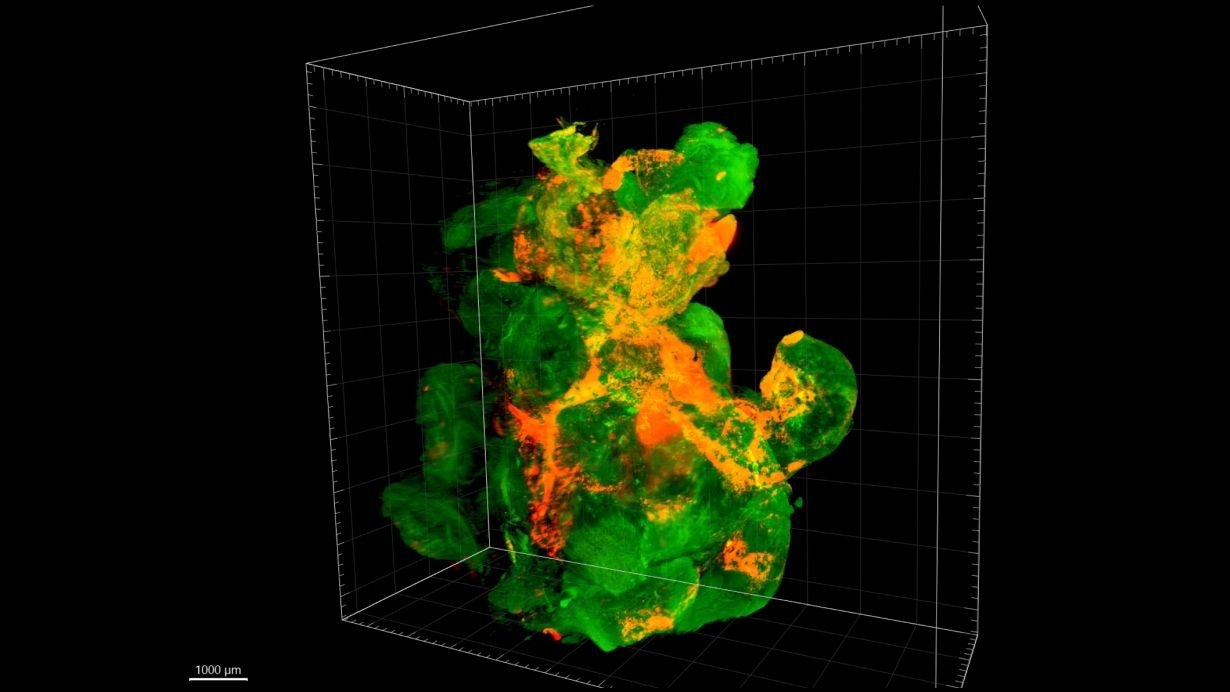One of the deadliest tumors that affect people is pancreatic cancer. In the Western world, it ranks as the fourth most common cause of cancer-related fatalities.
 A tumor under the fluorescence microscope: the tissue of this pancreatic tumor in a mouse glows green, the nanoparticles orange. Image Credit: Myrto Ischyropoulou/Max Planck Institute for Multidisciplinary Sciences
A tumor under the fluorescence microscope: the tissue of this pancreatic tumor in a mouse glows green, the nanoparticles orange. Image Credit: Myrto Ischyropoulou/Max Planck Institute for Multidisciplinary Sciences
Since the disease frequently progresses in its early stages without symptoms, diagnosis occurs much later. An additional issue is that advanced tumors can no longer be completely removed, together with their metastases. Chemotherapies, in turn, target healthy cells all over the body in addition to the tumor cells.
Innovative nanoparticles could provide a new technique for more precisely treating cancer. A study team from the Max Planck Institute (MPI) for Multidisciplinary Sciences, the University Medical Center Göttingen (UMG), and the Karlsruhe Institute of Technology (KIT) created the technique. The therapy is now being optimized for clinical use as soon as possible.
The approach promises to treat pancreatic cancer with greater precision and fewer side effects than conventional cancer treatments. Here, nanoparticles were used to deliver enormous quantities of the active substance Gemcitabine straight into the tumor.
Targeting the drug in high concentrations into the tumor cells with the help of the nanoparticles increases the efficacy and spares healthy cells. This can reduce the severe side effects that occur with Gemcitabine. Currently, patients are given the free drug. This is distributed throughout the body and can lead to toxic effects in all parts of the body. The nanoparticles, on the other hand, release the drug mainly in the tumor.
Myrto Ischyropoulou, Study Lead Author and Doctoral Student, University of Göttingen
Joanna Napp, Scientist at the UMG and the MPI, added, “Using imaging methods, we have already been able to demonstrate in mouse models that the nanoparticles accumulate in the tumors.”
Nanoparticle administration also makes it possible to go around the tumor’s resistance mechanisms.
Free Gemcitabine is often no longer taken up by the tumor very early on and is thus largely ineffective there. However, it still leads to considerable side effects, for example in the liver and kidneys. By using a different uptake mechanism in tumor cells, our nanoparticles could be a very effective new therapeutic approach here.
Claus Feldmann, Professor, Institute of Inorganic Chemistry, Karlsruhe Institute of Technology
The research success, according to Frauke Alves, group leader at the MPI and UMG, is an excellent representation of successful interdisciplinary cooperation.
From the idea to the development of the new nanoparticles to preclinical testing, chemists, biologists, pharmacists, and physicians have worked hand in hand.
Frauke Alves, Group Leader, University of Göttingen
The scientists are currently striving to expedite the transition of their novel nanoparticles from the test stage to clinical application through a spin-off.
Journal Reference:
Ischyropoulou, M., et al. (2023) High-Load Gemcitabine Inorganic–Organic Hybrid Nanoparticles as an Image-Guided Tumor-Selective Drug-Delivery System to Treat Pancreatic Cancer. Advanced Materials. doi:10.1002/adma.202305151.